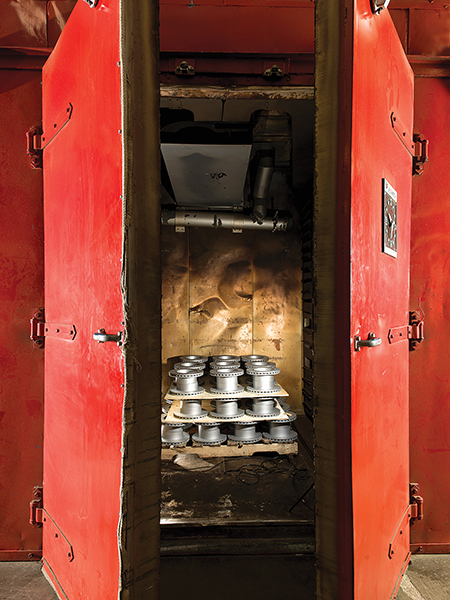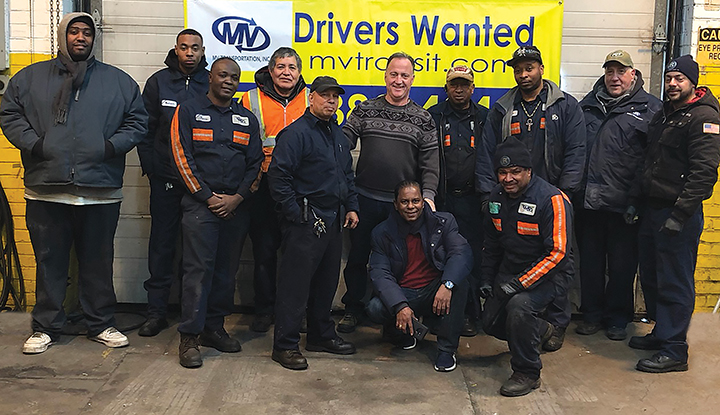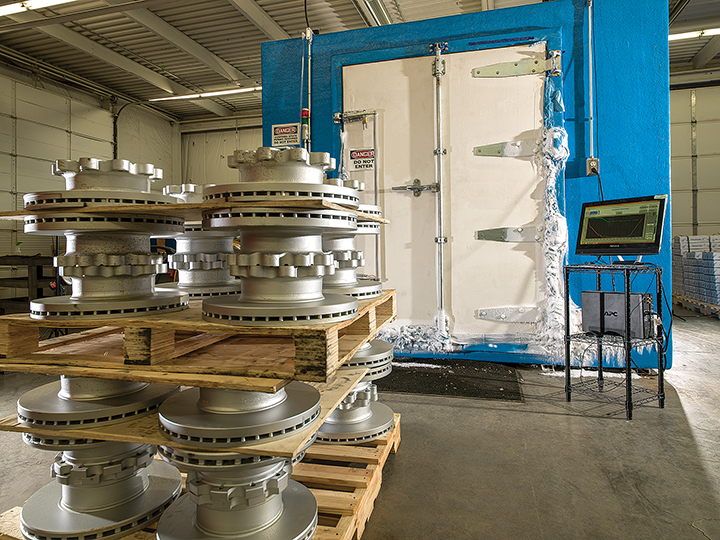
By Richard Tackett
When Sruly Lowy approached Joe Smith, regional vice president of MV Transportation, in May of 2015, claiming that cryogenically-treated brake rotors could provide a 300 percent increase in rotor life, Smith was noticeably skeptical. In his career — dating back to his former positions as president of MTA Bus and Long Island Bus, and senior vice president of New York City Transit Authority — hundreds of people had pitched him products with supposed amazing results — and most had failed to deliver those results.
Lowy described the Cryo Rotor treatment: a dry process where liquid nitrogen is converted into a gas before coming in contact with the rotors placed inside the processor, causing temperatures to drop drastically. The Cryo Rotor process significantly lengthens the lives of tools and enhances their performance capabilities. For brakes, Lowy said, MV would realize the aforementioned increase in rotor life, as well as significant savings in costs for maintenance and labor, improved performance and safety, and a decrease in wear rate and surface roughness. Furthermore, he claimed that MV would see a measurable reduction in cracking and warpage of the rotors, a significant factor in repairing and replacing brakes.
MV Transportation is the largest privately-owned firm for passenger transportation contracting services in the United States, and in his position, Smith was adamant to make every penny count. Lowy, who handles customer service and distribution on the east coast for 300 Below, remained persistent, until Smith agreed to a trial.

The Cryo Rotor®
300 Below, which has a history spanning over 50 years as a company, specializes in the cryogenic tempering of engines, transmissions, ring and pinions, axles, turbo-chargers, and brake rotors and drums for race cars, sports cars, muscle cars, buses, commercial vehicles and many other applications. 300 Below’s process is specifically designed for applications where breakage and excessive wear need to be reduced.
“My wife likes to say, ‘We spank the molecules and make them behave,’” Pete Paulin, chief executive officer of 300 Below, said. “The Cryo Rotor process affects a change in structural coherence of the rotors’ iron, and that coherence lends itself to an increase in heat transmissivity — so that the brakes don’t fade and also see improvement in abrasive-wear resistance.”
Iron components like brake rotors, Paulin said, see 250- to 400-percent increases in lifespan. Furthermore, due to 300 Below’s formula-specific brake pad material, the company can concurrently double (and sometimes triple) a brake pad’s lifespan. This is a significant reduction in cost, as brake pads are typically changed two or three times over the changeout of a specific rotor or brake drum.
The cost savings can be significant when factored into the expected expenses of corrosion and deterioration of brake parts due to harsh duty cycles often seen as a result of extreme weather. 300 Below’s Cryo Rotor product is designed to withstand the harshest of weather and provide a lifetime guarantee against warpage.

MV tests Cryo Rotor®
MV Transportation’s New England region works in a variety of transportation modes: school bus, paratransit, corporate shuttle and commuter bus. It services an area consisting of approximately 2,600 square miles and provides roughly 200,000 annual trips.
Smith went to Dean Carbonaro, MV regional director of maintenance, about implementing the trial. Carbonaro manages maintenance on roughly 2,000 vehicles. Carbonaro and Smith had their eyes on a certain part of the fleet which they considered “horrendous” on brake pads: the Ford 350, 450 and 550 vehicles, as well as the 4500 series Chevrolet cutaway work vans.
“Those vehicles were doing a huge amount of mileage,” Smith said, “and we were only getting 12,000 miles of life per pad. After the second set of pads, we were into the rotors and those were shot.”
Carbonaro said the Chevrolet vans servicing New York’s Putnam County were only providing 8,000 to 10,000 miles of service before needing to replace the manufacturer-provided brake shoes, making that vehicle the perfect candidate for the Cryo Rotor trial. He began the trial by placing four new rotors and brake pads provided by 300 Below.
Carbonaro was pleased to find that same vehicle ran for 28,000 miles on the new brake pads, and with barely any wear on the rotors.
“We started using the vehicle, then expanded the test to more vehicles,” he said. “We would check the Cryo-Rotor-equipped vehicles every 30 days, to make sure the product was performing like 300 Below promised. I think some of the rotors actually performed better than what they promised.”
Yielding positive results
With the trial completed to MV’s satisfaction, the Cryo Rotor was deployed to all buses, vans and other vehicles in the northeast fleet with a model year 2008 and later.
Immediately, MV saw a major reduction in labor and maintenance costs due to less frequent brake changeouts. Carbonaro found that, since the product is lasting longer, vehicles now didn’t require the previously-accepted three pad changes per brake.
“I also save a lot on labor and downtime on the bus,” he said. “I’d much rather have the bus on the road carrying passengers than sitting in the shop receiving brake maintenance, if that’s possible.”
Another noticeable benefit came in freed-up heavy-duty vehicle lift space in MV Transportation’s maintenance bays. Lift space is work space, and it is especially critical with sometimes more than 300 vehicles in a single location.
“We’ve got to make every space count,” Smith said. “And with at least a 50 percent increase in brake pad life, that means a lot less lift space is taken up by vehicles equipped with the Cryo Rotor.”
Previously, MV’s school buses would deal with a significant amount of rust due to their sitting dormant during the summer season.
“Rust is a problem of the past due to 300 Below’s Cryo Rotor process, which essentially eliminates rust wear,” Smith said.
Smith indicated that MV Transportation is also pleased with the reduced rotor warpage, as it reduces breakdowns caused by brake pedal pulsing, and with the elimination of brake fade caused by the heavy-duty Ford 500 vehicles’ constant stopping and starting.
Joe Smith, standing at center, serves as regional vice president of transportation for MV Transportation.
Increased safety
The cryogenically-treated rotors have had a measurable effect on stopping distance. Using Vericom brake meters, MV Transportation has recorded a 10- to 20- percent improvement on stopping distance since switching to 300 Below’s brake pads and rotors.
“Safety is everything in transportation,” Smith said. “We never want to see a panic-stop situation, but with a shorter stopping distance we can possibly prevent a rear-end collision, and an injury on the bus or to a pedestrian. It improves our safety and makes us a better company.”
Moving forward
According to Smith, MV Transportation is able to cut maintenance costs per mile, every year, without jeopardizing safety, thanks to 300 Below’s Cryo Rotor brake parts. To Smith, this represents the best of both worlds.
“Maintenance people can be funny,” he said. “They often think OEM products are the best, without question, but that’s not always the case. OEM-supplied brakes and brake components are simply not the best options available. When you show them the results we’re getting, they’re utterly amazed at the improvement in performance.”
“Using cryogenically-processed brake components puts us on the leading edge of what maintenance should be in this day and age — making every penny count without sacrificing an inch in safety,” Smith said.

